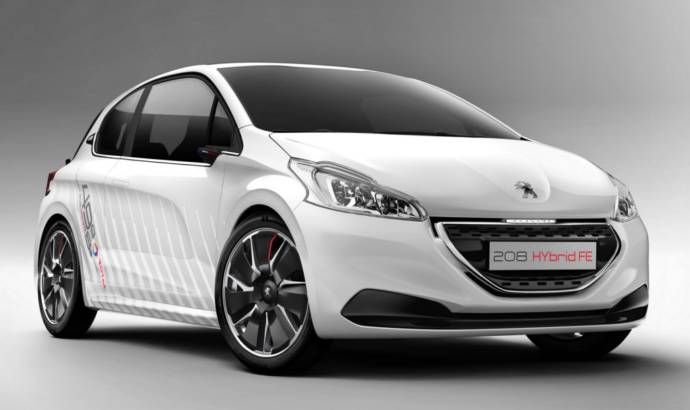At the Frankfurt Motor Show, PEUGEOT and Total will unveil their technological concept, the 208 HYbrid FE, a full petrol hybrid with exceptional characteristics and without a Plug-in energy source. The Research and Development teams the two partners rose brilliantly to the challenge proposed by establishing a remarkable level of performance, based on a production PEUGEOT 208 hatchback: 0 to 100km/h / 0 to 62mph in 8.0 seconds and CO2 of just 49g/km over the official NEDC European Drive Cycle (Combined Cycle figure).
The objective of the 208 HYbrid FE is to combine real driving pleasure with low CO2 emissions. More precisely, the intention is to halve the CO2 emissions of the PEUGEOT 208, equipped with the 1.0- litre VTi 68 and to provide it with acceleration comparable to a performance hatchback, so quite a challenge! The challenge is made all the greater for the teams of the 208 HYbrid FE project as the production PEUGEOT 208 is already renowned for its weight-saving design and its latest-generation engines that allow it to offer a high-level driving experience. To rise to this challenge, Total and PEUGEOT therefore combined their capacity for innovation in all areas capitalising on the virtuous circle initiated by the hatchback.
The 3-cylinder engine has undergone several modifications: optimisation of the engine operational cycle, reduction of friction losses, thermomanagement… All of these advances lead to fuel economy improvements by 10% yet with power maintained at 68bhp (50kW).
The engine adopts direct injection which, by means of very precise phasing with the closing of the cylinder, maximises the benefit of each molecule of fuel. The variable setting at the inlet and at the exhaust extends the range of optimum efficiency to the entire engine speed range, both at full load and partial load. However, not all of these various developments favour power at high engine speed. So, the capacity is modified to 1,233cm3 by increasing the bore and the stroke (75mm x 93mm) to maintain the declared 68bhp (50kW). On the other hand, this progress benefits the maximum torque produced which increases by 25%. All of the moving components are specific to the 208 HYbrid FE. The nitrated steel crankshaft, the titanium con rods and the aluminium-copper alloy pistons are cut from solid. So, their weight is reduced in spite of the increase in capacity; the con rods and Gudgeon pins being halved. The friction losses are a challenge as they represent approximately 1/5th of the power consumed by an engine.
During deceleration phases, whether by releasing the accelerator pedal or through braking, the vehicle is slowed down primarily by the electric motor. The hydraulic braking only comes into operation at the end of braking phase to maximise the recovery of the energy available. Over one homologation cycle, this recovery is 25%. Then, on acceleration, this energy is returned and assists the petrol engine according to various parameters: acceleration dictated by the driver and the gear selected.
The PEUGEOT and Total teams, who have been working for months on creating this technological demonstrator, can be justifiably proud.Up until now, there have been low consumption vehicles and high performance vehicles. For the first time, these two qualities are combined in the same vehicle.



